
Digital learning uses technology to make education more flexible, accessible, and personalized. It connects you to resources and tools that adapt to your learning needs, whether you're in a classroom or studying independently. This approach has grown rapidly, with the global e-learning market projected to reach nearly $400 billion by 2026. Over 40% of Fortune 500 companies now rely on it, and online learning has expanded by 900% since 2000. As technology evolves, digital learning plays a critical role in preparing you for the future, equipping you with skills that match the demands of a fast-changing world.
Digital learning changes lessons to fit how you learn best. It helps you stay interested and motivated.
A big advantage of digital learning is easy access. You can learn from anywhere, no matter your situation.
Use digital tools to keep learning new skills for jobs. This helps you stay ready for changes and learn tech skills.
Cool tools like AI, VR, and games make learning fun. They also make it easier to understand and remember.
Stay safe online by picking trusted websites and strong passwords. This keeps your personal info safe while you learn.
Digital learning has transformed how you access and engage with education. It combines technology with innovative teaching methods to create a flexible and personalized learning experience. This section explores its definition, core components, functionality, and tools that make it effective.
Digital learning refers to the use of technology to deliver educational content and experiences. It goes beyond traditional classrooms by offering interactive, accessible, and personalized learning opportunities. At its core, digital learning focuses on three main components: personalization, interactivity, and accessibility.
Core Component | Description |
|---|---|
Personalization | Adaptive learning programs tailor courses to fit your unique learning style and challenges. |
Interactivity | Engaging tools encourage active participation, improving your understanding and retention of concepts. |
Accessibility | Technology ensures that learning materials are available to you anytime, anywhere, regardless of location or ability. |
These components work together to create a dynamic and inclusive learning environment. For example, adaptive learning systems adjust to your pace and preferences, while interactive platforms keep you engaged.
Digital learning systems use advanced technologies to deliver personalized educational experiences. They rely on tools like learning analytics, adaptive algorithms, and big data to understand your needs and provide customized content.
Here’s how it works:
Personalized Learning: Platforms analyze your progress and adapt lessons to match your strengths and weaknesses. This approach boosts motivation and engagement.
Adaptability: Systems adjust to your prior knowledge, interests, and goals, ensuring that the content remains relevant and effective.
Learning Analytics: Data-driven insights help educators identify your learning patterns and tailor their teaching strategies accordingly.
For instance, adaptive learning technologies implemented at Arizona State University led to a 10% increase in student retention rates. These systems not only enhance your learning experience but also improve outcomes on a larger scale.
A variety of tools power digital learning, each designed to improve engagement and outcomes. Some popular examples include:
Learning Management Systems (LMS): Platforms like Moodle and Blackboard organize course materials, track progress, and facilitate communication.
Gamified Learning Apps: Tools like Kahoot! and Quizlet make learning fun by incorporating game elements, which increase motivation.
Virtual Classrooms: Platforms like Zoom and Microsoft Teams enable real-time interaction between you and your instructors.
Adaptive Learning Software: Programs like DreamBox Learning adjust content based on your performance, helping you master concepts at your own pace.
Studies highlight the effectiveness of these tools. For example, DreamBox Learning reported a 30% increase in student engagement and a 25% improvement in math proficiency after just 60 minutes of weekly use. Similarly, gamified learning has shown to boost retention rates by 34%, making it a powerful method for keeping you interested in your studies.
Digital learning has revolutionized education by making it more accessible and inclusive for everyone. It removes barriers that traditional classrooms often create, such as geographical limitations or physical disabilities. With digital tools, you can access high-quality education from anywhere in the world, whether you're in a rural village or a bustling city.
Inclusive education settings, supported by digital platforms, lead to better academic outcomes for all students. For example:
Students in inclusive classrooms perform better on standardized tests and have higher graduation rates.
Those with disabilities in inclusive settings are 15% more likely to achieve proficiency in reading and math compared to segregated settings.
Universal Design for Learning (UDL) principles provide multiple ways to engage, represent, and express ideas, enhancing learning for everyone.
Digital learning also fosters inclusivity by offering tools like screen readers, closed captions, and multilingual content. These features ensure that students with diverse needs can participate fully in their education. As a result, graduation rates increase by 10% in inclusive environments, creating a more equitable future for all learners.
One of the most significant advantages of digital learning is its ability to personalize education. Unlike traditional classrooms, where everyone follows the same pace, digital platforms adapt to your unique learning style, strengths, and challenges. This approach ensures that you stay engaged and motivated throughout your educational journey.
Research shows that personalized learning leads to remarkable improvements in academic performance. For instance:
Students in personalized learning environments score 30% higher on standardized tests compared to those in traditional classrooms.
Schools using personalized strategies see a 12% increase in attendance and a 15% drop in dropout rates.
Motivation levels soar, with 75% of students feeling more engaged compared to just 30% in regular classrooms.
These outcomes highlight how digital learning tailors education to meet your needs. Whether you're excelling in math or struggling with reading, adaptive technologies ensure that you receive the right support at the right time. This personalized approach not only boosts your academic success but also builds your confidence as a learner.
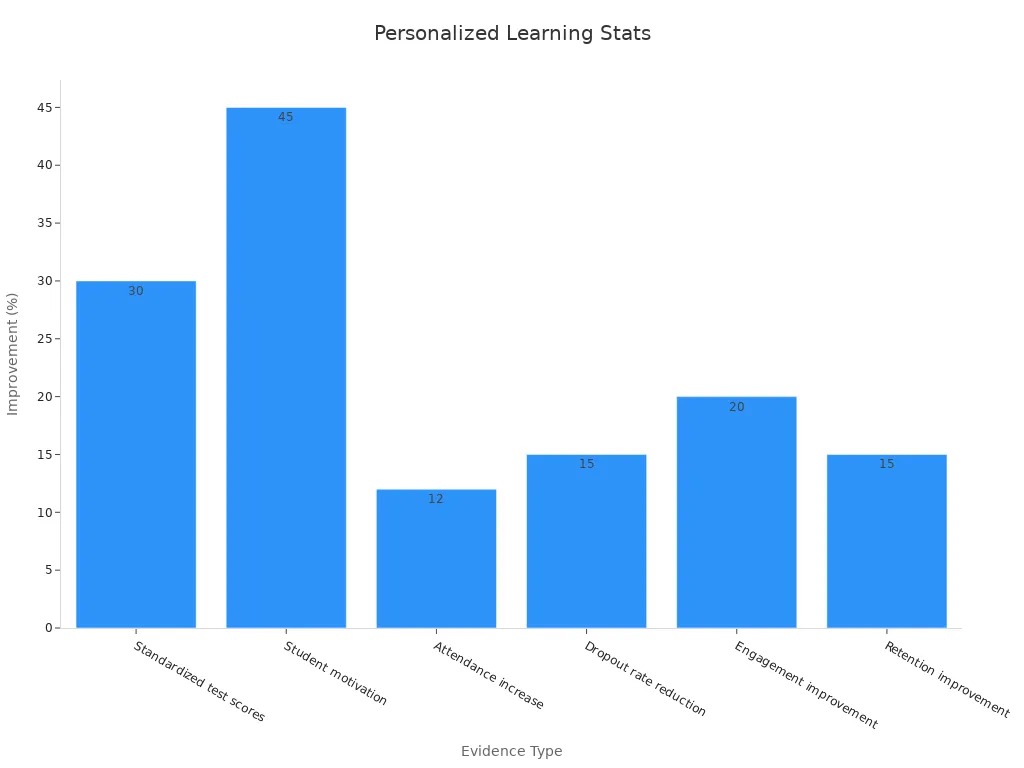
The world of work is changing rapidly, and digital learning plays a crucial role in preparing you for the jobs of tomorrow. According to the World Economic Forum, nearly 70% of students today will hold jobs that don't yet exist. This means you need skills that go beyond traditional education, such as coding, data analysis, and problem-solving.
Digital learning equips you with these essential skills through interactive courses, virtual internships, and real-world simulations. For example, coding bootcamps have helped 66% of graduates secure jobs within three months. These programs bridge the gap between education and employment, ensuring you're ready to tackle future challenges.
The demand for digital skills is also growing at an unprecedented rate. Here's a snapshot of the market forecasts:
Forecast Description | Value (USD) | Year |
|---|---|---|
Global IT training market expected value | 2025 | |
Estimated global IT training market value by 2034 | 157.84 billion | 2034 |
Global corporate e-learning market expected value | 457.8 billion | 2026 |
Big Data market value in 2023 | 327.26 billion | 2023 |
Big Data market growth rate (CAGR) | 14.9% | 2024-2030 |
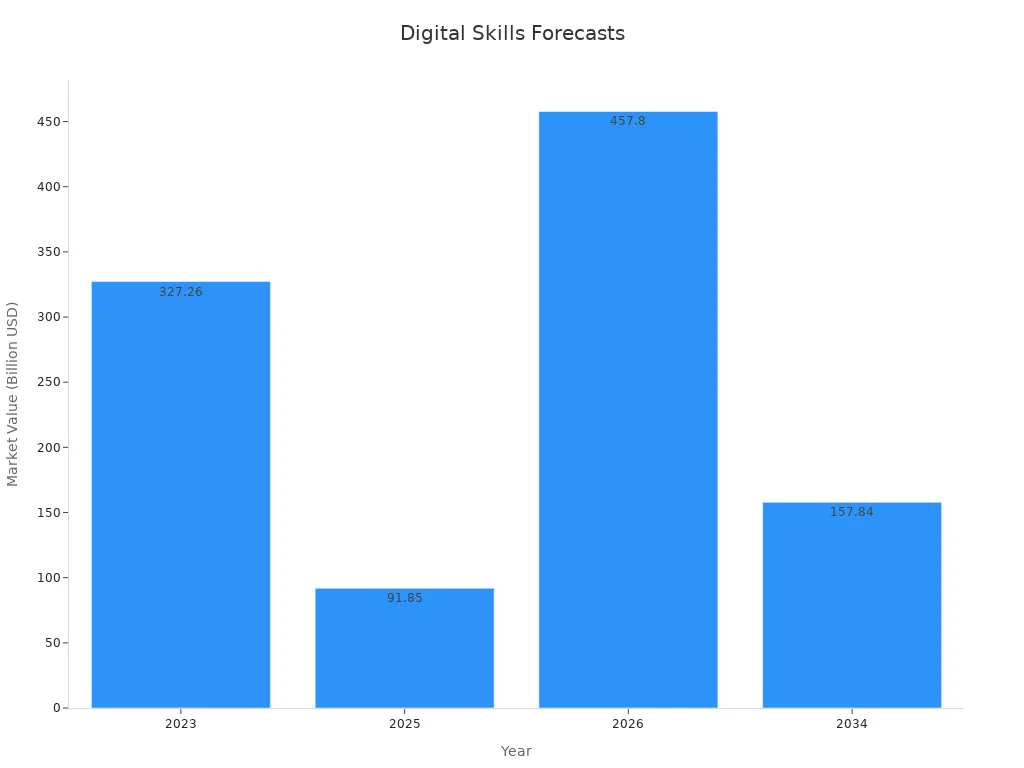
Employers increasingly value candidates with digital expertise. A survey by the National Association of Colleges and Employers found that 70% of employers prefer candidates with relevant internship experience. Digital learning provides you with opportunities to gain this experience, making you a competitive candidate in the job market. By investing in your education today, you're setting yourself up for a successful and fulfilling career tomorrow.
The digital skills gap refers to the mismatch between the skills people have and the skills employers need in a technology-driven world. As industries adopt advanced technologies, the demand for workers with digital expertise grows. Without these skills, you may face challenges in securing jobs or advancing in your career. Addressing this gap is essential for both individual success and economic growth.
The digital skills gap affects everyone. It limits opportunities for individuals and slows innovation for businesses. For example:
Individuals: You may struggle to find jobs that require technical skills like coding, data analysis, or cybersecurity.
Businesses: Companies face difficulties in filling roles, leading to reduced productivity and slower growth.
Economies: Nations with large skill gaps risk falling behind in global competitiveness.
A study by McKinsey found that 87% of companies worldwide already experience skill shortages. This highlights the urgency of equipping yourself with the right tools to thrive in the digital age.
Digital learning plays a crucial role in closing the digital skills gap. It offers flexible and accessible ways for you to acquire the skills employers value. Here’s how:
Skill-Specific Courses: Platforms like Coursera and Udemy provide targeted training in areas like programming, artificial intelligence, and cloud computing.
Certifications: Online certifications validate your expertise, making you stand out to employers.
Real-World Simulations: Tools like virtual labs let you practice skills in realistic scenarios, preparing you for workplace challenges.
For example, Google’s Career Certificates program has helped thousands of learners gain job-ready skills in fields like IT support and data analytics. These programs empower you to learn at your own pace, ensuring you stay competitive in the job market.
When you address the digital skills gap, you unlock numerous benefits:
Higher Employability: You become eligible for high-demand roles, increasing your chances of landing a job.
Career Growth: Advanced skills open doors to promotions and leadership positions.
Economic Impact: A skilled workforce drives innovation and boosts national economies.
Governments and organizations worldwide recognize these benefits. Initiatives like the European Union’s Digital Skills and Jobs Coalition aim to train millions of people in essential digital competencies. By participating in such programs, you contribute to a brighter future for yourself and society.
Tip: Start small by exploring free resources like YouTube tutorials or open-source coding platforms. These tools can help you build foundational skills before diving into advanced courses.
The digital landscape evolves rapidly, making lifelong learning essential. You must continuously update your skills to stay relevant. Digital learning platforms make this easier by offering new courses and certifications regularly. Whether you’re a student, a professional, or someone looking to switch careers, embracing lifelong learning ensures you remain adaptable in a changing world.
By addressing the digital skills gap, you not only secure your future but also contribute to a more innovative and inclusive society. Digital learning provides the tools you need to succeed, empowering you to thrive in the digital age.
The digital divide remains one of the biggest obstacles to effective digital learning. Not everyone has equal access to technology or the internet, which limits opportunities for many learners. This gap is especially evident across different demographics.
Demographic Group | Internet Access (%) | Source |
|---|---|---|
Women (2017) | 12% lower than men | International Telecommunications Union |
Households < $30,000 | Pew Internet and American Life Project | |
African Americans | 49% | Pew Internet and American Life Project |
Hispanics | 51% | Pew Internet and American Life Project |
Teachers in low-income areas | 50% support for tech | Pew survey of teachers |
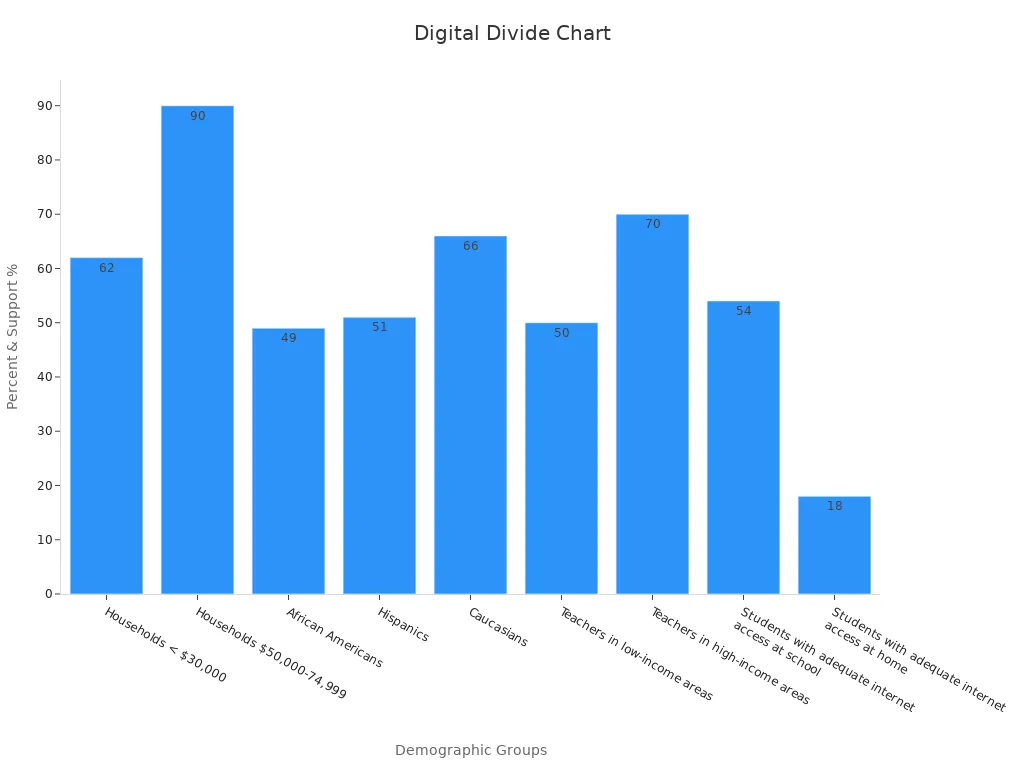
These disparities highlight the need for targeted solutions. For example, urban teachers often report poor internet access at school, while rural teachers face challenges at home. Addressing these issues requires investment in infrastructure, affordable devices, and community programs to ensure everyone can participate in digital learning.
Note: Bridging the digital divide not only improves access but also fosters equity in education, giving every learner a fair chance to succeed.
Keeping students engaged in digital learning environments can be challenging. Reduced oversight often leads to lower motivation, especially for students who struggle with self-discipline. Additionally, the lack of interpersonal interaction can hinder the development of critical skills and a sense of belonging.
To boost engagement, you can adopt strategies proven to work:
Shift from passive lectures to active learning approaches.
Gamify lesson plans to make learning fun and interactive.
Incorporate real-world applications to show the relevance of lessons.
Build a strong sense of community to reduce feelings of isolation.
For example, universities have found that students returning to campus after the pandemic often feel disconnected. By leveraging technology creatively and encouraging collaboration, educators can help students feel more connected and motivated. Gamified learning platforms like Kahoot! have shown significant success in increasing participation, while collaborative tools like Google Workspace promote teamwork and interaction.
Teachers play a crucial role in the success of digital learning, but many lack the training and resources needed to use technology effectively. Tailored, practical, and ongoing professional development is essential for helping educators integrate digital tools into their teaching.
Here’s how technology can support teacher development:
Facilitate collaboration among educators to share best practices.
Provide access to low-cost devices and platforms like WhatsApp for ongoing training.
Offer programs that improve digital literacy and pedagogical skills, such as initiatives in Africa and Ghana.
For instance, digital education programs in Africa have successfully enhanced teachers' ability to use technology in classrooms. These initiatives demonstrate that with the right support, educators can overcome barriers and create engaging learning experiences for students.
Tip: Schools and governments should prioritize teacher training programs to ensure educators feel confident and equipped to navigate digital learning environments.
Privacy and security are vital in digital learning. As you engage with online platforms, your personal data becomes vulnerable to breaches and misuse. Protecting this information ensures a safe and trustworthy learning environment.
One major concern is the rising number of data breaches in the education sector. In 2021, 48% of data breaches occurred in this field, highlighting the risks you face when using digital tools. Cybersecurity incidents in schools exceeded 400 in 2020, showing how widespread these issues have become. Many organizations struggle to implement robust security measures, with only 48% having comprehensive protections for their learning management systems (LMS).
Statistic Description | Percentage/Count |
|---|---|
Organizations reporting security breaches in the past year | 60% |
Companies with comprehensive security measures for LMS | 48% |
Data breaches occurring in the education sector in 2021 | 48% |
Educational leaders believing encryption is essential | 71% |
Cybersecurity incidents in schools in 2020 | Over 400 |
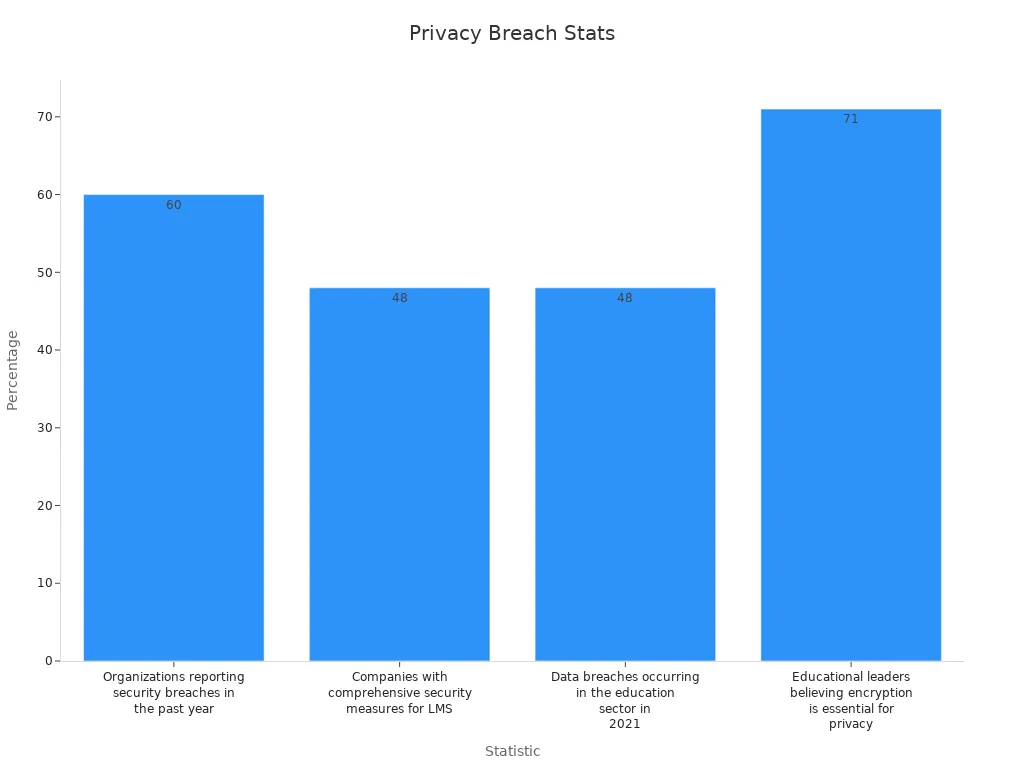
Encryption plays a crucial role in safeguarding your data. About 71% of educational leaders agree that encryption is essential for maintaining privacy. Without it, sensitive information like your login credentials, grades, and personal details could fall into the wrong hands.
To protect yourself, choose platforms that prioritize security. Look for features like two-factor authentication and encrypted communication. Avoid sharing unnecessary personal information online. By staying vigilant, you can enjoy the benefits of digital learning without compromising your privacy.
Tip: Always update your passwords regularly and use strong, unique combinations to reduce the risk of unauthorized access.
Privacy and security are not just technical challenges; they are essential for creating a safe and inclusive digital learning experience. By understanding these risks and taking proactive steps, you can ensure your online education journey remains secure.
Artificial intelligence (AI) is transforming how you learn by creating highly personalized educational experiences. AI-powered platforms analyze your strengths and weaknesses to deliver tailored lessons that match your needs. For example, AI tutoring systems can monitor your progress and provide instant feedback, helping you improve faster.
Study | Findings | Quantitative Outcomes |
|---|---|---|
AI-integrated educational apps | AI responds to students' emotional states in real time | |
ChatGPT in Physics classrooms | Increased interest in science courses | Positive perceptions of AI's role in learning |
AI tutoring systems | Improved student performance outcomes | Enhanced teaching and learning experiences |
AI also plays a role in learning analytics. By analyzing data, it helps educators understand your learning patterns and adjust their teaching strategies. This technology ensures that you receive the right support at the right time, making your learning journey more effective.
Virtual reality (VR) and augmented reality (AR) are revolutionizing education by immersing you in interactive and engaging environments. These tools make complex concepts easier to understand. For instance, VR-based physics lessons have been shown to improve understanding of difficult topics.
Study | Findings |
|---|---|
Otterbein University | Students reported positive impacts from VR in a cell biology course. |
UK Study | VR users performed better in remembering information than traditional methods. |
Kizilleff et al. (2018) | AR creates personalized learning experiences, improving academic outcomes. |
Wouters et al. (2013) | VR-based lessons significantly enhanced understanding of complex concepts. |
Bailenson et al. (2012) | VR in history classes improved critical thinking and problem-solving skills. |
As VR and AR equipment becomes more affordable, you can expect these technologies to become a standard part of digital learning. They not only make lessons more engaging but also cater to different learning styles, ensuring better outcomes for everyone.
Gamification is reshaping how you engage with education. By incorporating game elements like rewards and challenges, it makes learning fun and interactive. This approach boosts your motivation and helps you retain information more effectively.
Gamification fosters collaboration and teamwork, preparing you for real-world challenges.
It improves learning outcomes by using rewards and feedback loops to encourage progress.
Studies show that gamified tools can lead to performance improvements equivalent to a year of traditional learning in just one month.
For example, a study in Spain found that students using gamified tools demonstrated significant learning improvements. Gamification also allows you to learn at your own pace, making it an excellent option for resource-limited environments. By turning lessons into engaging experiences, gamification ensures that you stay motivated and achieve your goals.
Microlearning focuses on delivering small, easily digestible lessons that fit into your busy schedule. This approach breaks down complex topics into bite-sized modules, making it easier for you to absorb and retain information. Instead of overwhelming you with lengthy lectures, microlearning provides quick, targeted lessons that you can complete in minutes.
This strategy has proven to be highly effective. Many organizations report increased engagement and better learning outcomes when using microlearning. For example:
Learners often feel more motivated because the content is concise and to the point.
Social media tools, like short videos or interactive quizzes, make it easier to track engagement through metrics such as shares and views.
Microlearning reduces cognitive load, helping you focus on one concept at a time.
A study by the Society for Human Resource Management revealed that companies using microlearning saw a 130% boost in employee engagement and productivity. This highlights how smaller lessons can make a big impact. Whether you're learning a new language or mastering a technical skill, microlearning ensures that you stay focused and achieve your goals.
Tip: Incorporate microlearning into your routine by setting aside just 10 minutes a day for focused study. Over time, these small efforts add up to significant progress.
Data analytics is transforming education by helping educators make informed decisions and improve learning outcomes. By analyzing data, schools can identify trends, predict student performance, and tailor teaching strategies to meet your needs. This ensures that you receive the support necessary to succeed.
The demand for professionals skilled in education data analytics is growing rapidly. Here’s a snapshot of key roles in this field:
Role | Average National Salary | Predicted Job Growth Rate |
|---|---|---|
Education Statistician | $99,000 | 30% |
Psychometrician | $91,000 | 6% |
Education Research Analyst | $62,000 | 19% |
Education Data Scientist | $103,000 | 35% |
Institutional Researcher | $98,000 | 17% |
Academic Performance Analyst | $76,000 | 11% |
Learning Analyst | $81,000 | 6% |
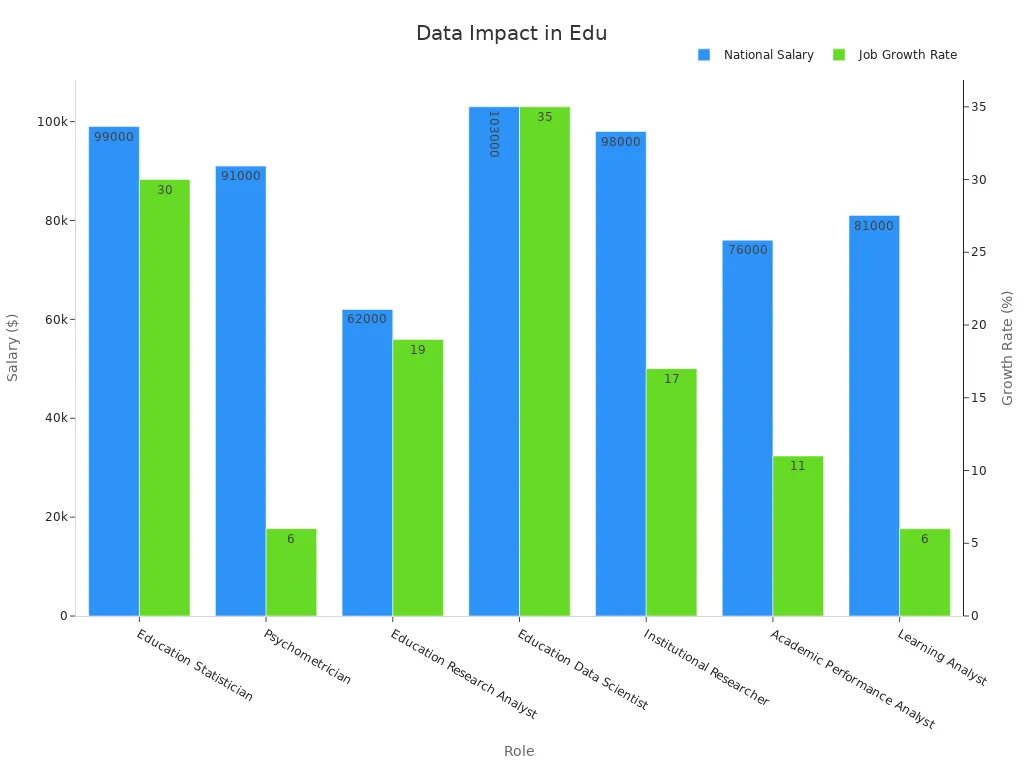
These roles highlight the importance of data-driven decision-making in education. For example, learning analysts use data to identify which teaching methods work best for you. This ensures that your educational experience is both effective and personalized. By embracing data analytics, schools can create a future where every student has the tools to thrive.
Note: If you're interested in this field, consider exploring online courses in data science or educational research to build your skills.
Digital learning has revolutionized education by making it more engaging, collaborative, and personalized. Platforms like Khan Academy boost your engagement with gamified content, while tools such as Google Classroom foster collaboration and critical thinking. AI-powered systems, like IBM Watson Tutor, provide tailored support, helping you grasp concepts more effectively. These innovations create a dynamic learning environment that adapts to your needs.
In 2025, digital learning will continue to break barriers, offering accessible and future-ready education. By embracing this approach, you prepare yourself for a world driven by technology and innovation. Take the first step toward a brighter educational future today.
Digital learning offers flexibility. You can learn at your own pace, anytime, anywhere. It also provides personalized content tailored to your strengths and weaknesses, making education more effective and engaging.
Digital learning removes barriers like location and physical disabilities. Tools like screen readers, captions, and multilingual content ensure everyone can access quality education, regardless of their circumstances.
Many digital learning tools are free or affordable. Platforms like Khan Academy and Coursera offer free courses. Some advanced tools may require subscriptions, but they often provide significant value for the cost.
Set clear goals and create a schedule. Use gamified platforms to make learning fun. Engage with online communities for support and accountability. Short, focused study sessions can also help maintain your interest.
Most platforms prioritize security with encryption and two-factor authentication. However, you should use strong passwords and avoid sharing personal information unnecessarily. Always choose reputable platforms to ensure your data stays safe.
Tip: Explore free trials of digital learning tools to find the ones that suit your needs best.